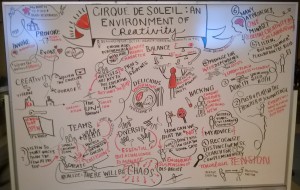Let’s imagine the university of the future. Actually, let’s write a mission statement for that university.
Our university would be “an international laboratory of creativity” built “on values and deep convictions which rest on a foundation of audacity, creativity, imagination and our people: the backbone of our success.”
It would place “creativity at the core of all its endeavors so as to ensure limitless possibilities” and give faculty, staff and students “the necessary freedom to imagine their most incredible dreams and bring them to life.”
Sort of takes your breath away, doesn’t it?
Unfortunately, we’re unlikely to see a university like that anytime soon – something that should make us ask why – but we could bring that type of thinking into the classroom.
To do that, let’s go to Cirque du Soleil. That’s where the quoted material above comes from. I looked it up after listening to Bernard Petiot’s plenary session last week at the annual conference of the International Society of the Scholarship of Teaching and Learning. Petiot, vice president for casting and performance at Cirque du Soleil, delivered what was easily the most entertaining session at ISSOTL, and perhaps the most useful.

His speech had nothing to do with college teaching, and at the same time it had everything to do with college teaching. That’s because he talked about managing creative people. Cirque du Soleil prides itself on putting creative minds together and reimagining the possible. It expects tension, failures and lots of uncertainty. By learning from failures, though, using the tension as inspiration and pushing through the uncertainty, the organization’s performers and managers create something truly spectacular.
That’s what all teachers wish of their students – perhaps not immediately, but eventually.
A circus performance, like education, doesn’t come easily. Petiot offered these gems of wisdom about the process.
- Creativity is not linear. It can sometimes be chaotic.
- Creative results sometimes face periods of ambiguity and dissenting ideas.
- If ideas are killed too soon you may miss an opportunity to really create.
- A creation generates change. It defies established paradigms
- Creativity generates tension by necessity. That tension allows new thinking and new solutions, so embrace the insecurity.
- Creativity requires courage.
As Petiot spoke last week, Brianna Smrke stood at the back of the room, sketching the speech in what she called “graphic recording.”
Smrke never knows in advance what a speaker will say, she said. Indeed, that’s part of the artistic challenge: zeroing in on the key aspects, turning them into comprehensible material, pacing the drawing so as not to fill up the board too quickly or too slowly, and ultimately creating a lively narrative that reflects a speech but becomes a piece of art in itself.
Essentially, Smrke lived Petiot’s words as he spoke them, managing her own tension and embracing the uncertainty.
So look at the bullet points from Petiot’s speech again and substitute “innovative teaching” for “creativity.” That sounds like a university of the future to me.
Doug Ward is an associate professor of journalism and the associate director of the Center for Teaching Excellence. You can follow him on Twitter @kuediting.